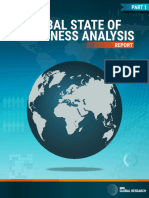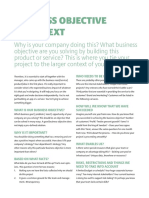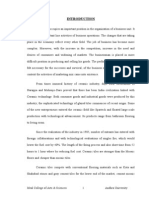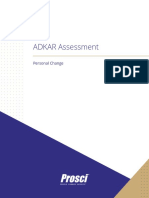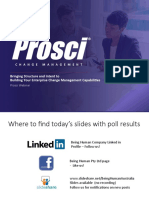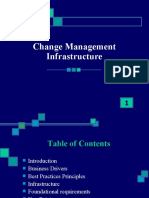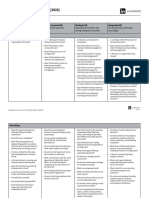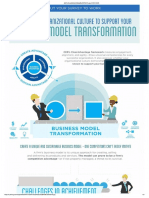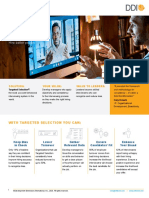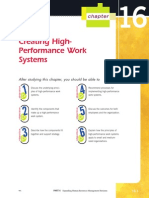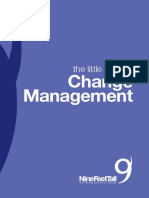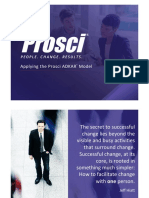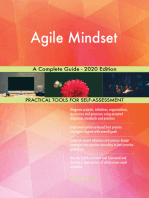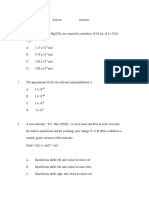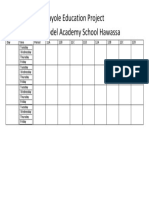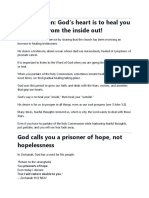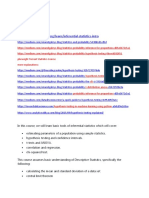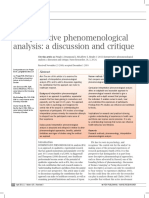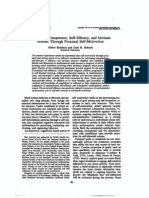Managing Change: Self-Assessment Questions and Answers
Managing Change: Self-Assessment Questions and Answers
Uploaded by
wondimuCopyright:
Available Formats
Managing Change: Self-Assessment Questions and Answers
Managing Change: Self-Assessment Questions and Answers
Uploaded by
wondimuOriginal Description:
Original Title
Copyright
Available Formats
Share this document
Did you find this document useful?
Is this content inappropriate?
Copyright:
Available Formats
Managing Change: Self-Assessment Questions and Answers
Managing Change: Self-Assessment Questions and Answers
Uploaded by
wondimuCopyright:
Available Formats
Managing Change
February 2010
Self-Assessment
Questions and Answers
The views expressed in this document are not necessarily those of the Fasset Seta
Valuing Diversity in the Workplace Q & A
July 2009
SELF ASSESSMENT QUESTIONS AND ANSWERS
This self-assessment has been designed to allow you to test the understanding and knowledge that you have
gained from attending the Fasset 2010 Managing Change Seminar. It comprises 20 multiple-choice questions
and should take you about 35 minutes to complete. Note that in some instances multiple answers may be
correct.
1) Managing change is about:
a) Crisis and conflict management
b) Aligning the organisation and its people to the environment
c) Improving performance in individuals and organisations
d) All of the above
2) Types of change that organisations need to manage are:
a) Developmental
b) Transitional
c) Transformational
d) All of the above
3) Which of the following are reasons why organisations engage in managing change:
a) To make employees feel inferior
b) To become more flexible and to adapt to the changing environment
c) To decrease productivity
d) An organisation does not need to manage change
4) Which of the following statements best describes change management::
a) An analysis of the external trends impacting on the organisation
b) Identification and removal of blockages within the organisation
c) Improving the effectiveness of organisations and teams
d) All of the above
5) Lewin’s three step change model is based on the following steps:
a) Refreeze, transition, unfreeze
b) Transition, freeze, refreeze
c) Unfreeze, refreeze, unfreeze
d) Unfreeze, transition, refreeze
6) Which of the following is not one of the ADKAR change model processes:
a) Awareness
b) Desire
c) Determination
d) Knowledge
e) Ability
f) Reinforcement
7) Go through the following statements and indicate which are TRUE and which are FALSE.
a) Change does not need to be managed, it will sort itself out
b) Managing change requires specific competencies that need to be learned
c) Organisational changes don’t affect individuals in the organisation
d) Managing change is the same as crisis management”
8) The Change Management Matrix consists of the following four divers:
a) Pressure, vision, capacity and action
b) Leadership, vision, skills and pressure
c) Strategy, leaders, managers and staff
d) Pressure, strategy, skills and staff
9) The PDCA change management process is made up of the following::
a) Plan
b) Provision
c) Do
d) Determine
e) Calculate
f) Check
g) Act
h) Attend
10) When implementing a change process, which level of creating a Shared Vision is essential::
a) Telling
b) Selling
c) Testing
d) Consulting
e) Co-creating
Managing Change Q & A
February 2010
11) Which if the following factors is least important when selecting a change strategy::
a) Degree of resistance
b) Target population
c) Finance
d) The stakes
e) Time frame
f) Expertise
g) Dependency
12) Match the following descriptions with the correct change strategy:
12.1. People are social beings and will adhere to cultural a) Empirical research
norms and values. Change is based on redefining and
reinterpreting existing norms and values, and developing
commitments to new ones
12.2. People are basically compliant and will generally do what b) Normative Re-educative
they are told or can be made to do. Change is based on the
exercise of authority and the imposition of sanctions
12.3. People oppose loss and disruption but they adapt readily c) Power Coercive
to new circumstances. Change is based on building a new
organisation and gradually transferring people from the old
one to the new one
12.4. People are rational and will follow their self-interest — d) Environmental Adaptive
once it is revealed to them. Change is based on the
communication of information and the proffering of incentives
13) Which is the worst way to change organisational culture:
a) Create value and belief
b) Enforce the new culture
c) Practice effective communication
d) Review organisational structure
e) Redesign approach towards recognition
f) Review all work systems
Managing Change Q & A
February 2010
14) When putting together a change management plan, you should::
a) Involve all stakeholders
b) Analyse the systemic causes and effects
c) Remain flexible
d) Penetrate the organisational culture
e) All of the above
15) The role of the change agent is to:
a) Initiate and lead the change process
b) Manage stakeholders and resources
c) Get rid of negativity immediately
d) A and B
e) A, B and C
16) Which of the following should not be the role of the change agent::
a) Facilitator
b) Project Manager
c) Educator
d) Clown
17) The new role of HR in the Change Management process should be::
a) As a strategic business partner
b) As a support function to the core functions
c) As an ad-hoc partner to projects
d) As an extra resource when required
18) Change management often fails because of::
a) Miss starts
b) Making change an option
c) Focussing only on process
d) Focussing only on results
e) Not involving stakeholders
f) Delegated to outsiders to do
g) No change in the reward system
h) No follow-through
i) All of the above
Managing Change Q & A
February 2010
19) An integrated tool for measuring the impact of change in the organisation are :
a) ROI
b) Project cost
c) Project time
d) The results chain
e) All of the above
20) Organisational resilience works through which of the following four stages::
a) Reduction
b) Readiness
c) Shock
d) Response
e) Recovery
f) Results
Managing Change Q & A
February 2010
ANSWERS
Question Answer
1 D
2 D
3 B
4 D
5 D
6 C
7a F
7b T
7c F
7d F
8 A
9 A, C, F, G
10 E
11 C
12.1 B
12.2 C
12.3 D
12.4 A
13 B
14 E
15 D
16 D
17 A
18 I
19 D
20 A, B, D, E
Managing Change Q & A
February 2010
You might also like
- PCT Assessment Fillable v11Document4 pagesPCT Assessment Fillable v11bhargavi yNo ratings yet
- Prosci ADKAR Strategic Change Assessment WorksheetDocument2 pagesProsci ADKAR Strategic Change Assessment Worksheetside_line100% (3)
- 2023 Global State of Business Analysis ReportDocument16 pages2023 Global State of Business Analysis ReportTam PhanNo ratings yet
- Change Management Game EN A4 PDFDocument9 pagesChange Management Game EN A4 PDFR JNo ratings yet
- SOP For Continued Process VerificationDocument9 pagesSOP For Continued Process VerificationMubarak Patel100% (3)
- Prosci CLARC WorksheetDocument2 pagesProsci CLARC WorksheetShruti PatraNo ratings yet
- PWC Internal Change CapabilityDocument14 pagesPWC Internal Change CapabilityRamona PaulaNo ratings yet
- The Kübler-Ross Change Curve: Emotional Response To ChangeDocument9 pagesThe Kübler-Ross Change Curve: Emotional Response To ChangeChanel PostelNo ratings yet
- ADKAR WksheetDocument4 pagesADKAR Wksheetphillip_ngNo ratings yet
- Business Objectives Context CanvasDocument2 pagesBusiness Objectives Context CanvashosseinNo ratings yet
- EN Organizational Health Index and Organiza PDFDocument16 pagesEN Organizational Health Index and Organiza PDFbang jimmyNo ratings yet
- Chem Acid Base ExamDocument24 pagesChem Acid Base ExamwondimuNo ratings yet
- The Sins of The Mouth - Creflo Dollars PDFDocument36 pagesThe Sins of The Mouth - Creflo Dollars PDFwondimu100% (1)
- Transportation EngineeringDocument81 pagesTransportation EngineeringTyler Ross SmithNo ratings yet
- Consulting Report - Natura CosmeticosDocument201 pagesConsulting Report - Natura Cosmeticosneyke21No ratings yet
- Channel of DistributionDocument122 pagesChannel of Distributioncursorkkd100% (1)
- ADKAR Assessment Personal Fillable 2022Document4 pagesADKAR Assessment Personal Fillable 2022juliohansNo ratings yet
- Strategyand Cultures Role in Enabling Organizational ChangeDocument12 pagesStrategyand Cultures Role in Enabling Organizational ChangeMaria Jose Figueroa100% (1)
- ADKAR Empowering ManagersDocument12 pagesADKAR Empowering ManagersgeccisNo ratings yet
- Change Mgmt-CapabilityDocument10 pagesChange Mgmt-CapabilityBalraj AnandNo ratings yet
- Change Management 101Document26 pagesChange Management 101philip_kockNo ratings yet
- Agile Change Management - Ebook ChangefirstDocument15 pagesAgile Change Management - Ebook Changefirstmartha.ibanezdelccNo ratings yet
- OKR PilotDocument40 pagesOKR PilotTonkibakuNo ratings yet
- Strategic ArchitectureDocument36 pagesStrategic Architecturejaykar56No ratings yet
- Deloitte Belgium - Change Management PlaybookDocument33 pagesDeloitte Belgium - Change Management Playbookrakivanatan100% (1)
- Bringing Structure and Intent To Building Your Enterprise Change Management Capabili?esDocument74 pagesBringing Structure and Intent To Building Your Enterprise Change Management Capabili?estdeviyanNo ratings yet
- Change Communication Play BookDocument12 pagesChange Communication Play Bookozra1No ratings yet
- CM and Agile Executive Summary PDFDocument13 pagesCM and Agile Executive Summary PDFRomán Victor ChavezNo ratings yet
- Prosci Methodology Overview: An Integrated Approach To Deliver ResultsDocument49 pagesProsci Methodology Overview: An Integrated Approach To Deliver ResultsSpil_vv_IJmuidenNo ratings yet
- The 9 Traits of Future-Ready CompaniesDocument11 pagesThe 9 Traits of Future-Ready CompaniesVasanth RaghavanNo ratings yet
- The Project Manager of The Future: Developing Digital-Age Project Management Skills To Thrive in Disruptive TimesDocument16 pagesThe Project Manager of The Future: Developing Digital-Age Project Management Skills To Thrive in Disruptive TimesDiego TejadaNo ratings yet
- The Prosci ADKAR Overview Ebook PDFDocument18 pagesThe Prosci ADKAR Overview Ebook PDFIsrael Neri MoralesNo ratings yet
- ChangeManagementDocument8 pagesChangeManagementAnamica BhartiNo ratings yet
- Arsha Adkar Business WorksheetDocument4 pagesArsha Adkar Business WorksheetArsha JbNo ratings yet
- Cultural Transformation: in 9 StepsDocument7 pagesCultural Transformation: in 9 StepsMartín OropezaNo ratings yet
- Why Should Anyone Be Led by YouDocument2 pagesWhy Should Anyone Be Led by YouFaviola Denise CubiloNo ratings yet
- Oracle HCM Roadmap PDFDocument7 pagesOracle HCM Roadmap PDFAlice LinNo ratings yet
- Storytelling For Corporate ChangeDocument1 pageStorytelling For Corporate ChangeMaven TrainingNo ratings yet
- Maturity ModelDocument7 pagesMaturity Modelangermgmt100% (1)
- Strategic Agility in A Changing World 20190418Document12 pagesStrategic Agility in A Changing World 20190418Naveen Niraj100% (1)
- Prosci PCT CM ModelDocument16 pagesProsci PCT CM ModelHon VernaNo ratings yet
- Business Model TransformationDocument3 pagesBusiness Model Transformationfrancisco4bernal-8No ratings yet
- Understanding The People Side of Digital Business TransformationDocument24 pagesUnderstanding The People Side of Digital Business TransformationGeert Ouwerling100% (1)
- CH Change Management Plan TemplateDocument13 pagesCH Change Management Plan TemplatebtbowmanNo ratings yet
- Vision and Mission-Lecture 1 (Latest)Document60 pagesVision and Mission-Lecture 1 (Latest)Behnam AliabadiNo ratings yet
- Change Management 1: Business Challenges Severe CompetitionDocument12 pagesChange Management 1: Business Challenges Severe Competitionusman faisalNo ratings yet
- 10 Principles of Organization DesignDocument11 pages10 Principles of Organization DesignApolo BlasNo ratings yet
- Certification Program - Day 2 Additional Presentation InstructionsDocument6 pagesCertification Program - Day 2 Additional Presentation InstructionsLinaMacedoNo ratings yet
- Targeted Selection Solution OverviewDocument2 pagesTargeted Selection Solution OverviewManaswiNo ratings yet
- Free-AGS-Template-Change Management Tasks ChecklistDocument7 pagesFree-AGS-Template-Change Management Tasks ChecklistTexNo ratings yet
- Lean-Agile Leadership - Scaled Agile FrameworkDocument1 pageLean-Agile Leadership - Scaled Agile FrameworkYitaoNo ratings yet
- Prosci Webinar Slides: Part 1: Key Milestones of A New CM JourneyDocument17 pagesProsci Webinar Slides: Part 1: Key Milestones of A New CM JourneyLinaMacedoNo ratings yet
- Agile Leadership Workbook 1 CommunicationDocument44 pagesAgile Leadership Workbook 1 CommunicationGaryNo ratings yet
- Creating High-Performance Work Systems: After Studying This Chapter, You Should Be Able ToDocument34 pagesCreating High-Performance Work Systems: After Studying This Chapter, You Should Be Able ToVinceWijayaNo ratings yet
- Content Overview and OnboardingDocument29 pagesContent Overview and OnboardingMaria AngelNo ratings yet
- PROSCI Aug Cop Webinar Revisit Your Toolbox Slideshare-180821041406Document18 pagesPROSCI Aug Cop Webinar Revisit Your Toolbox Slideshare-180821041406Spil_vv_IJmuidenNo ratings yet
- Prosci PCT Single v11Document8 pagesProsci PCT Single v11ananth999No ratings yet
- IBCC Toolbox CompleteDocument16 pagesIBCC Toolbox CompleteNguyễn Huy Hoàng100% (1)
- The Little Book of Change ManagementDocument93 pagesThe Little Book of Change ManagementDr. hamza khraimNo ratings yet
- Applying The Prosci ADKAR ModelDocument51 pagesApplying The Prosci ADKAR ModelSpil_vv_IJmuidenNo ratings yet
- September Cop Webinar Revisiting Your Toolbox Part2-Applications of Adkar Slideshare-180924002407Document30 pagesSeptember Cop Webinar Revisiting Your Toolbox Part2-Applications of Adkar Slideshare-180924002407Spil_vv_IJmuidenNo ratings yet
- OCM Organizational OptimizationDocument1 pageOCM Organizational OptimizationfazalhkNo ratings yet
- DI Flexible OrganizationsDocument12 pagesDI Flexible OrganizationsHilvadiazNo ratings yet
- Requirements Management Plan A Complete Guide - 2019 EditionFrom EverandRequirements Management Plan A Complete Guide - 2019 EditionNo ratings yet
- 3 Ways To Activate The AnointingDocument3 pages3 Ways To Activate The Anointingwondimu100% (2)
- Acids QuizDocument462 pagesAcids Quizwondimu0% (1)
- BNBNDocument3 pagesBNBNwondimuNo ratings yet
- Wisdom For Financial SuccessDocument13 pagesWisdom For Financial SuccesswondimuNo ratings yet
- Hiwot Demissie Proposal FinalDocument35 pagesHiwot Demissie Proposal Finalwondimu100% (4)
- Chapter 1 Solution QuizeDocument19 pagesChapter 1 Solution QuizewondimuNo ratings yet
- 12 Model 23Document13 pages12 Model 23wondimuNo ratings yet
- Annual Lesson Plan 2012 Grade 12 ChemDocument18 pagesAnnual Lesson Plan 2012 Grade 12 Chemwondimu75% (4)
- Hayole Education Project PeriodDocument1 pageHayole Education Project PeriodwondimuNo ratings yet
- Joseph Prince 2019 Sept 1Document10 pagesJoseph Prince 2019 Sept 1wondimuNo ratings yet
- BelovedDocument5 pagesBelovedwondimuNo ratings yet
- Polymer Exam 2222Document8 pagesPolymer Exam 2222wondimuNo ratings yet
- Submission To GodDocument11 pagesSubmission To Godwondimu100% (1)
- Noah The Real Story: God Always Extends Chance After Chance, Opportunity After OpportunityDocument57 pagesNoah The Real Story: God Always Extends Chance After Chance, Opportunity After OpportunitywondimuNo ratings yet
- Meditations & Confessions For Health and Healing - by John OsteenDocument3 pagesMeditations & Confessions For Health and Healing - by John OsteenwondimuNo ratings yet
- Angelic Dominion Lost: "Have You Come To Torment Us Before Our Time?"Document25 pagesAngelic Dominion Lost: "Have You Come To Torment Us Before Our Time?"wondimuNo ratings yet
- Declarations by Charless CappsDocument2 pagesDeclarations by Charless Cappswondimu86% (7)
- Filled With The Fruits of RighteousnessDocument1 pageFilled With The Fruits of RighteousnesswondimuNo ratings yet
- 7 Verses About The Power of YourDocument9 pages7 Verses About The Power of Yourwondimu100% (1)
- Assessment QA's Managing ChangeDocument7 pagesAssessment QA's Managing ChangewondimuNo ratings yet
- EducationalDocument4 pagesEducationalwondimuNo ratings yet
- Playing A Trick On Uncertainty: F. Thomas BrussDocument6 pagesPlaying A Trick On Uncertainty: F. Thomas BrussmmdabralNo ratings yet
- IGTI Student Scholarship Program: Introduction and PurposeDocument3 pagesIGTI Student Scholarship Program: Introduction and Purposepolla2429No ratings yet
- Practical Research 2 DLP 26Document5 pagesPractical Research 2 DLP 26abellanamarzelleNo ratings yet
- Cornell 2013-14 STS CoursesDocument5 pagesCornell 2013-14 STS Coursescancelthis0035994No ratings yet
- Palluzi Cost Effective Pilot Plant Design ConstructionDocument29 pagesPalluzi Cost Effective Pilot Plant Design ConstructionMoises RomeroNo ratings yet
- An Interactive Approach To Good Clinical Practices (GCPS) : Brandi N. Ring, M.A. Boston University School of MedicineDocument57 pagesAn Interactive Approach To Good Clinical Practices (GCPS) : Brandi N. Ring, M.A. Boston University School of MedicinemeddouNo ratings yet
- The Cost of AbsenteeismDocument10 pagesThe Cost of AbsenteeismYoddhri DikshitNo ratings yet
- LR PDFDocument36 pagesLR PDFnoor ahmadNo ratings yet
- Oct 2019 SPSDocument3 pagesOct 2019 SPSWilly K. Ng'etichNo ratings yet
- look-inside-study-text-acca-performance-managementDocument9 pageslook-inside-study-text-acca-performance-managementahamza2523No ratings yet
- Assingnment of Business Statistics and OR - January To June 2020Document7 pagesAssingnment of Business Statistics and OR - January To June 2020priyanshi rankaNo ratings yet
- Big Five Personality MindfulnessDocument7 pagesBig Five Personality MindfulnessjonsmithNo ratings yet
- Arithmetic Mean (Population) = μ = =: Part 1Document17 pagesArithmetic Mean (Population) = μ = =: Part 1NodirPrimkulovNo ratings yet
- Creative Thinking Anthony Acevedo Online 230819Document46 pagesCreative Thinking Anthony Acevedo Online 230819Anthony AcevedoNo ratings yet
- Unit 6Document24 pagesUnit 6Sandipan ChakravortyNo ratings yet
- 2.1. Methodological Directions in Translation StudiesDocument12 pages2.1. Methodological Directions in Translation StudiesYousef Ramzi TahaNo ratings yet
- Unit Ii Eda Using RDocument11 pagesUnit Ii Eda Using Rpaseg78960No ratings yet
- Designing A Connectivist Flipped Classroom Platform Using Unified Modeling LanguageDocument19 pagesDesigning A Connectivist Flipped Classroom Platform Using Unified Modeling LanguageIrish NomorosaNo ratings yet
- A Study of Customer Satisfaction in Bihar Telecom Circle: Md. Mahmood Ul FaridDocument3 pagesA Study of Customer Satisfaction in Bihar Telecom Circle: Md. Mahmood Ul Faridgj657No ratings yet
- Unit 3- Data Storytelling-Practice QuestionsDocument5 pagesUnit 3- Data Storytelling-Practice QuestionsRashmi KaithNo ratings yet
- Influence of Marketing Strategy On Improving The FDocument11 pagesInfluence of Marketing Strategy On Improving The Fandreicosmin093No ratings yet
- Inferential Statistics in DetailsDocument652 pagesInferential Statistics in Detailsyousef shabanNo ratings yet
- Interpretative Phenomenological Analysis: A Discussion and CritiqueDocument6 pagesInterpretative Phenomenological Analysis: A Discussion and CritiqueKasia Wojciechowska100% (1)
- Chapter 4Document11 pagesChapter 4Bedri M AhmeduNo ratings yet
- Meiji Restoration: A New Industrialized JapanDocument3 pagesMeiji Restoration: A New Industrialized JapanJawad KhanNo ratings yet
- A Bandura y Schunk 1981Document13 pagesA Bandura y Schunk 1981Aida Reyes PardoNo ratings yet


